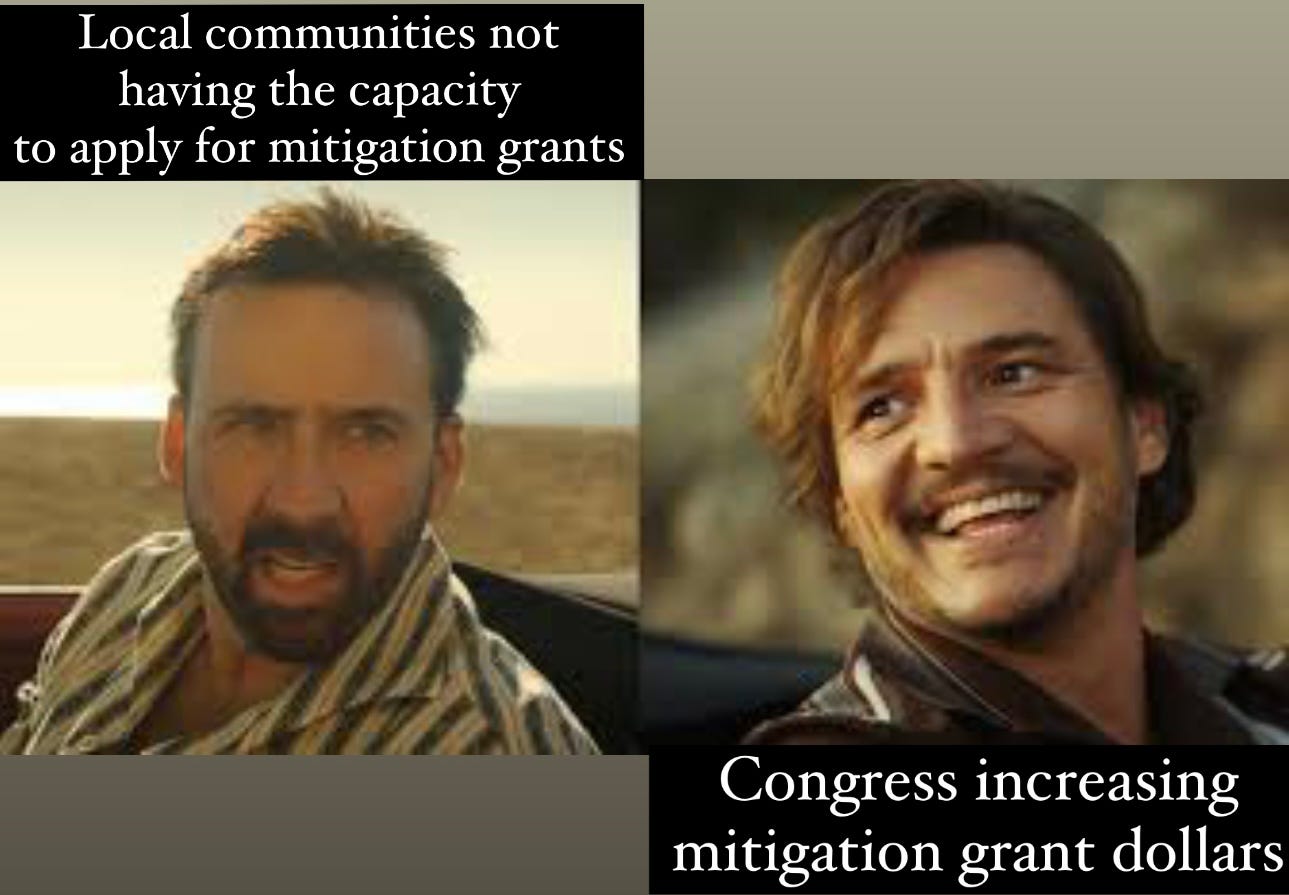This newsletter is a compilation of recent disaster ~things~ that I think are cool, important, or otherwise of interest to people who are intrigued with disaster (broadly defined).
There’s a little something for everyone!
The State of Emergency Management
Emergency Management Policy? Dumpster Fire.
Emergency Management Practice? Dumpster Fire.
The discipline of Emergency Management? Dumpster Fire.
Disaster Nonprofits: Dumpster Fire.
Private Disaster Contractors: Making Lots of Money
Some of y’all are going to say that’s harsh but am I wrong? Listen, I’ve not been in the best mood about emergency management this month. Bullshit abounds. For every step forward, we take four back. C’est la vie! Let’s see if we can muster up something constructive.
Public Expectations
I want to highlight this article from the LA Times. You might hit a paywall so I’ll summarize. The author talks about the various disasters that have happened in California in the past year with a particular emphasis on how the atmospheric river events have directly affected a greater portion of the state as compared to single wildfires. She goes on to explain that in the response to these disasters, people have relied on their family, friends, and neighbors to meet their basic needs as government has become overwhelmed. And, of course, that help has fallen along the lines of race and class with residents in communities like Pajaro receiving the least amount of assistance from government.
For those of us familiar with the emergency management system, this is a standard story. There’s nothing unique about how these responses have unfolded in California. It looks similar to what would happen in any other state.
What stood out to me about this story was one sentence in the middle of the article that read, “This is not how disaster response is supposed to work.”
And yet, what’s described in the article is a textbook case of the disaster response system working exactly as designed. What the author is, of course, signaling here is that what the public wants from government in a disaster, is different from what the government actually does in a disaster. This mismatch of expectations is a fundamental tension between emergency management that the field seems to have no intention of addressing.
Obviously, I agree that it shouldn’t work like this and that we need to reform the system to be more effective, efficient, and equitable. I think a lot of people in the public agree. The question is, as always, how to rally that public frustration into policy change.
Meme Break
A Petty Little Story.
There has been some tremendously bad emergency management takes this month. I feel like I’m in a game of Whac-a-mole. I simply refuse to spend my time deconstructing the op-eds and the podcasts (IYKYK) but there was one little incident that I’ll share here if you’ll indulge me.
In the immediate aftermath of the Mississippi tornado, a contingent of storm chasers (who I won’t name because I am very nice) threw what one might call a hissy fit because the NWS rated the tornado as an EF4 instead of an EF5. You might think, “okay, weird, but what does that have to do with us”. Well, a key point of their argument was that Mississippi wouldn’t get a Presidential Disaster Declaration (PDD) unless it was an EF5. I – lmao. Wut?
Some emergency managers on Twitter very kindly (bless y’all) set them straight about the declaration process. (If you’re unfamiliar with the process give it a read!) To be clear, they immediately received a PDD. The whole thing was a bit odd. I bring it up though because it was a real *chef’s kiss* example of how misinformation spreads when people don’t stay in their lanes.
Important Disaster Media Coverage This Month
Mitigation
Before disastrous flood, officials knew Pajaro River levee could fail but took no action in the Los Angeles Times
When it comes to earthquakes, Republicans and Democrats agree on L.A. retrofitting, poll finds in the LA Times
Pumps in key New Orleans flood protection system corroded is 5 years. They were meant to last 35 from NOLA.com
Retreat in Rodanthe in The Washington Post
Response
CDC team studying health impacts of Ohio train derailment fell ill during investigation from CNN
Pro-Moscow voices tried to steer Ohio train disaster debate from the AP
Recovery
For some Rolling Fork residents, recovery from Mississippi tornado is uncertain in The Washington Post
Insurers slashed Hurricane Ian payouts far below damage estimates, documents and insiders reveal in The Washington Post
The End Bits
I would love it if you’d forward this to your friends, post on social media, and undertake any other form of newsletter sharing you deem appropriate.
In case you signed up for this newsletter without knowing who I am (a bold choice!) you can read my book Disasterology: Dispatches From The Frontlines of The Climate Crisis to catch up! You can read a USA Today review here, order it here, or get it as an audiobook here. You can also find more from me on my blog, listen to this episode of Ologies, or follow me on Twitter and Instagram where I impulsively narrate my every thought.
Finally, this newsletter is ~FREE~. I plan on keeping it that way because eliminating barriers to disaster knowledge is important. However, I’ve created a “paid subscriber” option for $5 a month or whatever you’d like to give if you’re interested in supporting this work.





Disasters are real. Disaster connection to climate is 90% bullshit. There is no data showing increased frequency of hurricanes, tornados. floods, or droughts . Climate is warming very slowly, there’s Slight average increase in rainfall. That’s it. Stick to disasters.